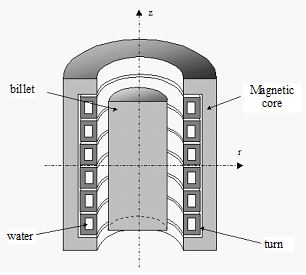Since version 2026, Flux 3D and Flux PEEC are no longer available.
Please use SimLab to create a new 3D project or to import an existing Flux 3D project.
Please use SimLab to create a new PEEC project (not possible to import an existing Flux PEEC project).
/!\ Documentation updates are in progress – some mentions of 3D may still appear.
2D Example: Induction heating with multiphysics coupling tutorial
Foreword
This paragraph is a summary of cases treated in detail in the 2D example: " Induction heating with multiphysics coupling tutorial".
The files relating to the studied cases, are accessible in the supervisor on the Open example context.
Studied device
The device to be analyzed is a cylindrical billet, heated by the Joule effect of the induced current.
The studied device, represented in the figure below, includes the following elements:
- Cylindrical billet
- 6-turns coil
- Magnetic core

Operating principle
The 6-turns coil in series is supplied by a source tension of 120V a.c. and a capacitor of 25 μF, is parallel connected to the coil.
We are interested in the temperature distribution and temperature progession evolution in the billet.
Materials
The device is composed of:
- ferrite – the material of the core
- steel – the material of the billet
- copper – the material of the 6 turns coil
Sources
The source of heat is the Joule losses in the billet.
Treated case
Four cases are demonstrated:
- case 1: computation of electromagnetic field and induced power density in the billet; parametric analysis (frequency and voltage as parameters). The billet and the magnetic core regions are magnetic non-linear. The simulation is performed using the steady state AC magnetic 2D application;
- case 2: single sequence between the Magnetic application and the Transient Thermal application during the start of the billet heating and a preliminary evaluation of the heating time. The billet and the magnetic core regions are magnetic non-linear; all the material properties are temperature independent. The simulation is performed using the steady state AC magnetic 2D application and the Transient Thermal application;
- case 3: multiphysics coupling between the Magnetic application and the Transient Thermal application during the heating process. The billet and the magnetic core regions are magnetic non-linear; all the material properties are temperature dependent . The simulation is performed using the steady state AC magnetic 2D application and the Transient Thermal application;
- case 4: multiphysics coupling between the Magnetic application and the Transient Thermal application during the heating process and the fast cooling of the billet in order to achieve the surface hardening. The billet and the magnetic core regions are magnetic non-linear; all the material properties are temperature dependent. The simulation is performed using the steady state AC magnetic 2D application and the Transient Thermal application;
Case 2
Physical phenomena are considered independent – the thermal variations of the electric resistivity and magnetic permeability of billet are not taken into consideration.
Cases 3 and 4
Physical phenomena are considered interdependent – the thermal variations of the electric resistivity and the permeability of billet are taken into consideration.